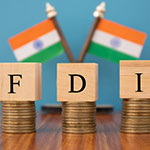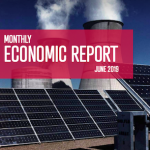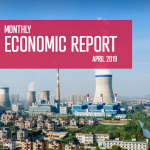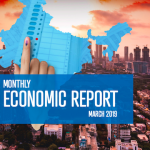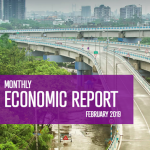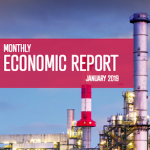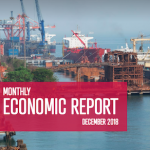-

Consolidated FDI Policy
It is the intent and objective of the Government of India to attract and promote foreign direct investment in order to supplement domestic capital, technology, and skills, for accelerated economic growth. Foreign Direct Investment, as distinguished from portfolio investment, has the connotation of establishing a ‘lasting interest’ in an enterprise that is resident in an economy other than that of the investor.
-

Economic Report (June 2019)
India’s US$2.7-trillion economy, the fastest-growing major economy in the world, is estimated to have grown by 6.8 per cent during fiscal 2018-19 ending March 31. The nation had recorded an average gross domestic product (GDP) growth of 7.5 per cent over the past five fiscals.
-

Indian Union Budget 2019-2020
The Union Minister for Finance and Corporate Affairs, Smt. Nirmala Sitharaman made her maiden Budget Speech on July 5 and presented the Union Budget 2019-20 before the Parliament.
10-point Vision for the decade- Building Team India with Jan Bhagidari: Minimum Government Maximum Governance.
- Achieving green Mother Earth and Blue Skies through a pollution-free India.
- Making Digital India reach every sector of the economy.
- Launching Gaganyan, Chandrayan, other Space and Satellite programmes.
- Building physical and social infrastructure.
- Water, water management, clean rivers.
- Blue Economy.
- Self-sufficiency and export of food-grains, pulses, oilseeds, fruits, and vegetables.
- Achieving a healthy society via Ayushman Bharat, well-nourished women & children, the safety of citizens.
- Emphasis on MSMEs, Start-ups, defense manufacturing, automobiles, electronics, fabs and batteries, and medical devices under Make in India.
-

Indian Economic Survey 2018-19
Prime Minister Shri Narendra Modi has laid down the vision of India becoming a US$5 trillion economy by 2025 and has inspired every citizen to contribute his or her bit to this worthy cause. In his words, “If every one of the 130 crore Indians takes one step forward, the country too will go that many steps ahead.” By laying out the strategic blueprint for fructifying this vision, the Survey extends its absolute commitment to a collective endeavour: 130 crore Indians creating an inclusive India by 2022 when we, as a nation, complete 75 years of Independence.
-

Economic Report (May 2019)
At the sectoral level, growth of agriculture, industry and services sectors is estimated to be 2.9 per cent, 6.9 per cent and 7.5 per cent, respectively, in 2018-19. During April 2019, the Index of Industrial Production (IIP) grew by 3.4 per cent, and by 3.6 per cent during 2018-19.
-

Economic Report (April 2019)
India’s US$2.6-trillion economy, the fastest-growing major economy in the world, is estimated to have grown by 6.8 per cent during fiscal 2018-19 ending March 31. Meanwhile, the revised gross domestic product (GDP) growth rates, released by the Central Statistics Office for the years 2015-16, 2016-17 and 2017-18, have been set at 8 per cent, 8.2 per cent and 7.2 per cent, respectively.
-

Indian automotive sector: Creating future-ready organisations – PWC, SIAM
The Indian automotive industry is seeing a significant transformation with respect to its sustainable growth and profitability. The industry is crucial for the economy as it accounts for 7.1% of the country’s Gross Domestic Product (GDP) and as per Automotive Mission Plan (AMP) 2016–26, its contribution is projected to increase to 12%. India is expected to emerge as the world’s third-largest passenger vehicle market by 2021.
-

Economic Report (March 2019)
India’s US$2.6 trillion economy, the fastest growing major economy in the world, is estimated to have grown by 7 per cent during fiscal 2018-19 ending March 31, compared with a growth of 7.2 per cent over fiscal 2017-18.
-

Economic Report (February 2019)
India’s US$2.6-trillion economy is estimated to grow by 7 per cent during fiscal 2018-19 ending March 31, 2019, compared with a growth of 7.2 per cent in fiscal 2017-18. Meanwhile, the average Gross Domestic Product (GDP) growth in the last five years has topped 7.5 per cent defining a new normal for the Indian economy
-

SAARC Social Charter India Country Report
Achieving inclusive growth has been one of the main priorities of the Government of India. The Government is implementing various programmes/schemes for creating better employment opportunities and improving the education and health status of all citizens for equitable and broad-based inclusive growth of the country. The “SAARC Social Charter India Country Report 2018” is the seventh country report which maps various programmes/schemes of Government of India targeted towards achieving the objectives of the SAARC Social Charter in the country.
-

National Manufacturing Policy
The Government of India has announced a National Manufacturing Policy with the objective of enhancing the share of manufacturing in GDP to 25% within a decade and creating 100 million jobs. The National Investment & Manufacturing Zones (NIMZs) are an important instrumentality of the manufacturing policy. The NIMZs are envisaged as integrated industrial townships with state of the art infrastructure; land use on the basis of zoning; clean and energy-efficient technology; necessary social infrastructure; skill development facilities etc. to provide a productive environment for persons transitioning from the primary to the secondary and tertiary sectors.
-

Economic Report (January 2019)
India’s US$2.6-trillion economy is estimated to grow by 7 per cent in fiscal 2018-19 ending March 31 2019, compared with a growth of 7.2 per cent in fiscal 2017-18. Meanwhile, the growth of Gross Value Added (GVA) at constant basic prices for the year 2018-19 is estimated to be 6.8 per cent, as against GVA growth of 6.9 per cent for 2017-18.
-

India’s ascent could change the fashion industry: McKinsey & Co, BoF
India is increasingly a focal point for the fashion industry, reflecting a rapidly growing middle-class and increasingly powerful manufacturing sector. These, together with strong economic fundamentals and growing tech-savvy, make India too important for international brands to ignore, as per a joint study by McKinsey & Co and Business of Fashion (BoF)
-

Economic Report (December 2018)
he growth of India’s real gross domestic product (GDP) for the first half of 2018-19 was 7.6 per cent, as compared with growth of 6 per cent in the first half of 2017-18. Meanwhile, the growth of Gross Value Added (GVA) at constant basic prices for the year 2018-19 is estimated to be 7.0 percent, as against GVA growth of 6.5 per cent (PE) for 2017-18.
-

RBI Report on Trend and Progress of Banking in India 2017-18
The global banking reform agenda made further progress in 2017-18. In India, the Reserve Bank ushered in a revised framework with the insolvency and bankruptcy code as the focal point in pursuit of declogging of banks’ balance sheets from the overhang of stressed assets. Going forward, issues such as recapitalisation, improvement in banks’ corporate governance, implementation of Ind-AS and containment of cyber security risks may assume prominence.
